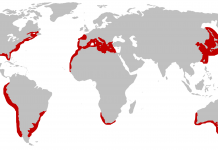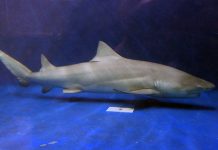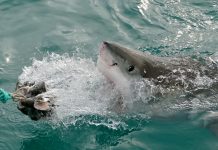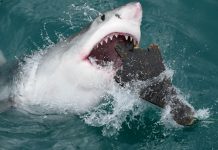Do you have any idea what do great white sharks eat? The great white shark diet consists of a wide range of food enabling it to eat from smaller animals like tuna, rays and skates and all the way up to larger ones like seals, sea lions and dolphins.
White sharks like to eat bony fish like lingcod, demersal rockfish and benthic flatfish. They also prey on big fishes like bluefin tuna and broadbill swordfish. The primary diet of this species, however, consists of small-toothed whales, carrion, small harbor and elephant seals, sea turtles and sea lions. Let us discuss great white shark diet.
What Do Great White Sharks Eat Facts?
They are also known to eat creatures like chelonians, chimaeroids, crustaceans and mollusks like cephalopods. Besides, penguins and cormorants also fall prey to the white sharks, though infrequently. They also feed on sharks and rays (elasmobranchs). The bigger individuals prey on odontocetes. Moreover, dead baleen whales also form part of white shark’s menu.
Whales, dolphins and porpoises are among the favorite food in crustaceans.
- In pinnipeds, white sharks like to feed on sea lions and seals.
- In dolphins, the great whites usually aim for the species of bottlenose dolphins, dusky dolphins, Humpback dolphins and Risso’s dolphins.
- As for porpoises, Dall’s porpoises and harbor porpoises are targeted most.
What Do Great White Sharks Like to Eat?
With a length of about 20 feet, the great white is an opportunistic predator. Taking advantage of its massive size and speed, it stalks many smaller marine species quite easily. Even other sharks and rays are not out of its harm’s way.
It is observed that the great white shark diet revolves mostly around marine mammals. In fact, they form the main component of its diet. Other than mammals, it also likes to feed on other sharks and rays, turtles, seabirds, crabs, snails, bony fish.
The white shark usually preys on large animals. But that doesn’t mean they are easy to grab. Those animals are also very strong and big predators in their own right (forming part of a food chain).
Since these sharks are highly curious animals, they tend to prey on almost anything that is available even if that object may not be easy to digest. However the individuals measuring less than 3 meters (9.8 feet) in length go after cartilaginous fish like rays, skates and even other smaller sharks. This is because their jaws are not fully developed and are not powerful enough like the adult individuals, which is why they do not readily feed on bigger animals like pinnipeds. The great whites are likely to aim for the thick layer of mammals’ blubber once they reach 4 meters (13 feet) in length.
Experiment of Peter Klimley on the diet of the Great White Shark
One experiment by a marine biologist Peter Klimley shows such sharks do not feast on everything rather they tend to pick out only the high-cal food and leave the rest. It means they seem to have a liking for a particular kind of food and leaps toward it, once they are sure it is an energy-rich prey.
By means of rod-and-reel rig, Peter used carcasses of three animals as bait (i.e. a sheep, a pig and a seal) off the coast of San Francisco on Farallon Islands. Out of all the three carcasses, the great whites did not feed on sheep carcass while they readily ate the remaining two.
What do Great White Sharks Eat list?
Seals
The great whites are not frightened to attack even the larger animals like northern elephant seals off the coast of California. The northern elephant seal weighs around 5,000 pounds and can go up to a length of about 14 feet. It’s not an easy prey by any standards even for the massive white sharks.
But it is noted that the great whites target these seals and with the help of strong jaws and teeth, it bites off the prey at its hindquarters. It is because this is the very portion of its body from where the seal controls its movement and therefore it becomes immobile once the shark attacks it with its jaws.
Because northern elephant seals are larger than the predator, the great whites do not feast on them right away rather allows the animal to die through bleeding. This is however not the case with the young elephant seals that are fairly easy to feed on.
As for the 290-pound common seal, the great white clamps it from the surface, then submerges it until it becomes immobile. Likewise, it attacks the California sea lion from below as it cruises to the surface and grips the animal at mid-body thanks to its terrifying stealth and speed.
With a stunning speed of 25 miles per hour, the great white ambushes the cape fur seals on the Seal Island of South Africa. The thrust of the shark enables it to leap into the air completely during such predatory assaults. These sharks tend to attack during dawn and dusk when the sun is at the low position.
Whales
It is almost certain that the great white shark also feeds on whale carcasses because after analyzing the contents of its stomach, it proves that the predator also preys on whale carcasses. However, what is still a mystery is the fact that whether the great white feeds on the flesh of a whale carcass or gets hold of the prey when it’s alive and then eat it. As of now, we do not have any verifiable accounts that show either of these assumptions to hold true.
But there is an evidence of the white shark’s attack on one of the three species of sperm whale family. Off central California (1989), a pygmy sperm whale was located and there was a scratch from the jaws of great white. The length of that whale was 1.8 meters (5.9 feet).
Dolphins and Porpoises
Since dolphins and porpoises use echolocation to detect the imminent danger, the great whites do not follow any regular pattern in stalking these individuals. It means the white sharks attack from behind or below, depending on their own preferences as well as the location of the prey. This strategy is used because the great whites do not want themselves to be caught through echolocation or else the dolphins can easily run off.







